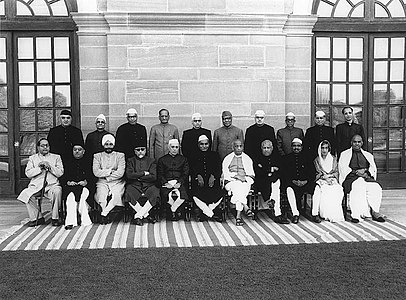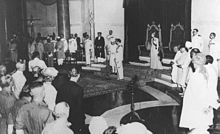First Nehru ministry
| First Nehru ministry | |
|---|---|
1st ministry of the Republic of India | |
 The cabinet of India on 31 January 1950, along with the newly appointed President Rajendra Prasad. (L to R sitting) B. R. Ambedkar, Rafi Ahmed Kidwai, Sardar Baldev Singh, Maulana Abul Kalam Azad, Jawaharlal Nehru, Rajendra Prasad, Vallabhbhai Patel, John Mathai, Jagjivan Ram, Rajkumari Amrit Kaur and S. P. Mukherjee. (L to R standing) Khurshed Lal, R. R. Diwakar, Mohanlal Saksena, N. Gopalaswami Ayyangar, N.V. Gadgil, K. C. Neogy, Jairamdas Daulatram, K. Santhanam, Satya Narayan Sinha and B. V. Keskar | |
| Date formed | 15 August 1947 |
| Date dissolved | 15 April 1952 |
| People and organisations | |
| King | George VI (1947-50) |
| President | Rajendra Prasad (1950-52) |
| Governor-General |
|
| Prime minister | Jawaharlal Nehru |
| Deputy Prime minister | Vallabhbhai Patel (until 15 December 1950) |
| Member party | Indian National Congress |
| Status in legislature | Majority 208 / 299 |
| Opposition party | None |
| Opposition leader | None |
| History | |
| Election(s) | 1945 Indian general election |
| Outgoing election | 1951 Indian general election |
| Legislature term(s) | 4 years and 8 months |
| Predecessor | Interim |
| Successor | Second Nehru ministry |
After power transformation, on 15 August 1947, Jawaharlal Nehru assumed office as the first Prime Minister of India and chose fifteen ministers to form the First Nehru ministry.
Background[]
The Constituent Assembly was set up while India was still under British rule, following negotiations between Indian leaders and members of the 1946 Cabinet Mission to India from the United Kingdom. The provincial assembly elections had been conducted early in 1946. The Constituent Assembly members were elected to it indirectly by the members of these newly elected provincial assemblies, and initially included representatives for those provinces which came to form part of Pakistan, some of which are now within Bangladesh. The Constituent Assembly had 299 representatives, including nine women.
The Interim Government of India was formed on 2 September 1946 from the newly elected Constituent Assembly. The Indian National Congress held a large majority in the Assembly, with 69 percent of all of the seats, while the Muslim League held almost all of the seats reserved in the Assembly for Muslims. There were also some members from smaller parties, such as the Scheduled Caste Federation, the Communist Party of India, and the Unionist Party. In June 1947, the delegations from the provinces of Sindh, East Bengal, Baluchistan, West Punjab, and the North West Frontier Province withdrew, to form the Constituent Assembly of Pakistan, meeting in Karachi. On 15 August 1947, the Dominion of India and Dominion of Pakistan became independent nations, and the members of the Constituent Assembly who had not withdrawn to Karachi became India's Parliament. Only 28 members of the Muslim League finally joined the Indian Assembly. Later, 93 members were nominated from the princely states. The Congress thus secured a majority of 82%.
Jawaharlal Nehru took charge as the first Prime Minister of India on 15 August 1947, and chose 15 other members for his cabinet. Vallabhbhai Patel served as the first Deputy Prime Minister until his death on 15 December 1950. Lord Mountbatten, and later C. Rajagopalachari, served as Governor-General until 26 January 1950, when Rajendra Prasad was elected as the first President of India.[1] [2]
Cabinet members[]

There were members from Hindu, Muslim, Christian, Sikh and Parsi communities represented in India's first ministry. There were two members from the Dalit community represented as well.[3][4] Rajkumari Amrit Kaur was the only female Cabinet minister. The following is a list of the ministers in the first Cabinet.[1]
- Key
| Portfolio | Minister | Took office | Left office | Party | |
|---|---|---|---|---|---|
| Prime Minister Minister of External Affairs and Commonwealth Relations Minister of Scientific Research | Jawaharlal Nehru | 15 August 1947 | Second Nehru ministry | INC | |
| Deputy Prime Minister | Sardar Vallabhbhai Patel | 15 August 1947 | 15 December 1950[†] | INC | |
| Minister of Home Affairs and States | Sardar Vallabhbhai Patel | 15 August 1947 | 15 December 1950[†] | INC | |
| C. Rajagopalachari[5] | 26 December 1950 | 25 October 1951[RES] | INC | ||
| Kailash Nath Katju | 1951 | Second Nehru ministry | INC | ||
| Minister of Information and Broadcasting | Sardar Vallabhbhai Patel | 15 August 1947 | 1949 | INC | |
| R. R. Diwakar[6] | 1949 | 15 April 1952 | INC | ||
| Minister of Finance | R. K. Shanmukham Chetty | 15 August 1947 | 1949 | INC | |
| John Mathai | 1949 | 1950[RES] | INC | ||
| C. D. Deshmukh | 1950 | Second Nehru ministry | INC | ||
| Minister of Law | B. R. Ambedkar[5] | 15 August 1947 | 1951[RES] | SCF | |
| Minister of Defence | Baldev Singh | 15 August 1947 | Second Nehru ministry | Panthic Party | |
| Minister of Railways and Transport | John Mathai | 15 August 1947 | 22 September 1948 | INC | |
| N. Gopalaswami Ayyangar | 22 September 1948 | Second Nehru ministry | INC | ||
| Minister of Education | Maulana Abul Kalam Azad | 15 August 1947 | Second Nehru ministry | INC | |
| Minister of Food and Agriculture | Rajendra Prasad | 15 August 1947 | 15 April 1952 | INC | |
| Minister of Industries and Supplies | Syama Prasad Mukherjee | 15 August 1947 | 6 April 1950[RES] | INC | |
| Harekrushna Mahatab | 13 May 1950 | 26 December 1950[RES] | INC | ||
| Minister of Labour | Jagjivan Ram | 15 August 1947 | 15 April 1952 | INC | |
| Minister of Commerce | Cooverji Hormusji Bhabha | 15 August 1947 | 15 April 1952 | INC | |
| Minister of Communications | Rafi Ahmed Kidwai | 15 August 1947 | 15 April 1952 | INC | |
| Minister of Health | Amrit Kaur | 15 August 1947 | 15 April 1952 | INC | |
| Minister of Works, Mines and Power | Narhar Vishnu Gadgil | 15 August 1947 | 15 April 1952 | INC | |
| Minister of Relief and Rehabilitation | K. C. Neogy | 15 August 1947 | April 1950[RES] | INC | |
| Minister without portfolio | N. Gopalaswami Ayyangar[7] | 15 August 1947 | 22 September 1948 | INC | |
| Mohanlal Saxena | 15 August 1947 | 15 April 1952 | INC | ||
References[]
- ^ a b Krishna, Ananth V. (2011). India Since Independence: Making Sense Of Indian Politics. India: Pearson Education India. pp. 34–36. ISBN 9788131734650. Retrieved 27 May 2014.
- ^ Ramachandra Guha, "India After Gandhi", Picador India, 2007. ISBN 978-0-330-39610-3
- ^ "The New Cabinet". Hindustan Times. 15 August 1947. Archived from the original on 30 March 2012. Retrieved 19 August 2011.
- ^ "New Cabinet of India". The Times of India. 15 August 1947. p. 1. Retrieved 19 August 2011.
- ^ a b http://www.livemint.com/Opinion/BDGqZmHMQlGbEuUT7jdObK/Dj-View--The-Chetty-affair.html
- ^ "Rajya Sabha Members, Biographical Sketches, 1952 – 2003: D" (PDF).
- ^ http://indiatoday.intoday.in/story/article-370-issue-omar-abdullah-jammu-and-kashmir-jawaharlal-nehru/1/364053.html
Further reading[]
- First Nehru ministry
- 1947 establishments in India
- Cabinets established in 1947
- Council of Ministers of India
- Indian union ministries
- 1952 disestablishments in India
- Cabinets disestablished in 1952